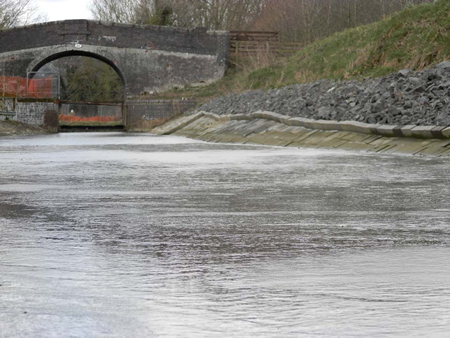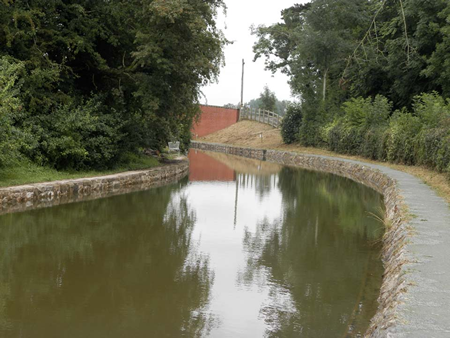


By Richard Starkey and Michael Aerts – The competition for water resources is growing globally, with the resolution of or the inability to effectively resolve these issues threatening economies, communities, and, in some regions, basic survival. A key objective of infrastructure and water management professionals is to ensure that breaches or breakdown within water resource networks are identifiable and rectifiable quickly. System failures are expensive and threaten the safety of communities.
Recent developments in water management and control systems have focused H&R ChemPharm (UK) Limited towards the development of a self-healing, super absorbent polymer (SAP) technology for water management systems.
The SAP product, Sahara®, can be impregnated within a substrate carrier (e.g., a nonwoven geotextile) to form a reactive, lightweight, and highly effective water- and chemical-resistant barrier. In this roll-delivered geosynthetic form, it can be efficiently brought to site and installed easily.
The combination of the super-absorbent polymer technology and the geosynthetic provides a long-term, effective solution to water containment and management.
SUPER ABSORBENT POLYMER GEOMEMBRANES
The chemical structure of Sahara® allows it to permanently bond to a supporting substrate, which offers applications in a wide spectrum of environments including canals and rivers, ponds and reservoirs, and drainage. The solution is applicable across a broad range of sectors, including mining, agriculture, civil engineering and infrastructure.
The SAP-coated substrate creates an immediate barrier when it comes into contact with water-based liquids. Once activated, the material absorbs up to 120 times its original weight, causing the SAP to swell; thus, creating a strong containment system with the added benefit of being a self healing geomembrane.
This activated geomembrane has been proven to be effective in the long term, including through repeated wet/dry and freeze/thaw cycles. Desiccation is not an issue. When the water-based liquid is no longer present, the barrier system reverts to its original, dry state and the super-absorbent polymer retains its ability to react, swell, and seal when liquid is reintroduced.
PROJECT STORY:
Montgomery Canal Regeneration
Montgomery Canal’s history can be traced back to the 1700s. It forms part of the Shropshire Union Canal, a key inland waterway in the United Kingdom. Running for 33miles (53km) and featuring 10 locks, the canal has been under restoration since 1968.
Canals and Rivers Trust (CRT) is entrusted with the care of this canal system as well as more than 2,000 miles (1243km) of inland waterways in England and Wales. In 2008, a decision was made by CRT to restore a 430m section of canal near Knockin in Shropshire.
The project was funded through the National Lottery Heritage Fund and The European Union Regional Funding.
The site to be rehabilitated had previously used a geosynthetic clay liner (GCL). GCLs feature a bentonite core that has a high-swelling capacity. In evaluating the suitability of the site to use GCL again, CRT also incorporated alternatives, including Sahara® Terraseal. They elected to utilize the super-absorbent polymer solution for the first time in the canal’s rehabilitation.
“The weight of the treated geotextile was much less than the previous liner that was being used and this sped up the laying process by a factor of around three times,” says Les Clarke, who has overseen the engineering works on the site for CRT.
Clarke expects that the immediate benefits they’ve realized will lead CRT to utilize the same liner system in some future projects.
Indeed, a second phase of the Montgomery Canal will utilize Terraseal for lining 200 linear meters of canal at a width of 14m.
SELECTING THE RIGHT LINING SYSTEM
Every barrier system (geosynthetic, compacted clay, hard surface) has its advantages in an application and for a particular site. For the Montgomery Canal project, the impregnated substrate solution offered the following:
- Logistics – Transportation and installation costs were reduced considerably due to the Terraseal system weight (600 gsm)
- Ease of Installation – The impregnated liner needed only to be overlapped to achieve the designed seal
- Speed of installation – Much of the work was carried out by volunteers, and overall the construction works were completed ahead of schedule. The canal was able to be reflooded in the summer of 2014—sooner than planned.
- Strength and Durability – The SAP-enhanced liner offered an effective long-term design while being robust enough to tolerate foot and light-vehicle traffic; thus, they did not have concerns about installation damage risks.
- Self-Healing Properties – The site’s redesign required concrete blocks over the lining system, which for any geosynthetic barrier add an element of damage risk. The SAP system performance, and specifically the ability to self-heal (swell to fill voids/penetrations), gave the site operators strong confidence in the integrity of the site during the final piece of Phase I’s construction activities.
- Excellent Barrier properties – This liner shows excellent barrier properties as reflected in the hydraulic conductivity typical value of 6.59 x 10 -12 m/s
Richard Starkey is Marketing Coordinator and Michael Aerts Business Manager (Sahara) for H&R ChemPharm (UK) Limited, www.hur.com.











